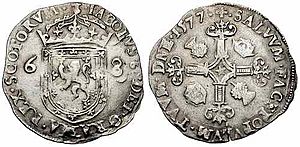Merk (coin) facts for kids
The merk was an old Scottish silver coin that is no longer used. It was first called a "money mark" of silver. The merk coin was used in the late 1500s and during the 1600s.
At first, one merk was worth 13 shillings and 4 pence in Scottish money. This was exactly two-thirds of a pound Scots. It was also worth about one shilling in English money. Later, its value went up to 14 shillings Scots.
Contents
What Was the Merk Coin?
Besides the regular merk, there were other coins too. These included the four merk, which was worth 56 shillings or £2 and 16 shillings. There was also the half merk, sometimes called a noble. This coin was worth 6 shillings and 8 pence.
Smaller coins included the quarter merk, worth 3 shillings and 4 pence. There was also the eighth-thistle merk, which was worth 20 pence.
How Much Silver Was in a Merk?
The very first merk coins weighed about 103.8 grains. They were made of half silver and half other metals. This means each coin had about 51.9 grains of pure silver.
Merkland: Measuring Land
The word "Markland" or "Merkland" was also used in Scotland. It described a certain amount of land in old legal papers. This way of measuring land was based on how much the land was worth.
Merks During the Lang Siege
During a time called the "Lang Siege" of Edinburgh Castle in 1572, special merks were made. This was the last part of the Marian civil war. A goldsmith named James Cockie made half merks inside the castle. At the same time, the people who supported James VI made their coins at Dalkeith.
James VI and the Merk
King James VI issued silver merks that had the lion of Scotland on one side. On the other side, they had a thistle, which is a Scottish symbol. The last Scottish silver merks made before Scotland and England joined under one king in 1603 were from 1601, 1602, and 1603. Some full thistle merks were even made in 1604.
On April 8, 1603, James VI (who also became James I of England) made the merk coin usable in England. There, it was worth 13.5 English pence.


